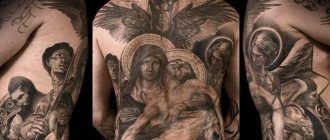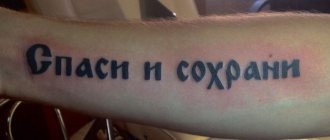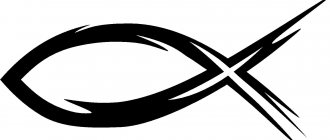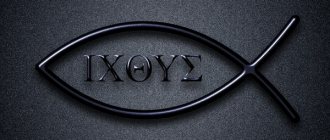Photo from:
A tattoo with the inscription “Only God is my judge” refers to religious slogans. Performed in lettering style with the addition of realism or old school style. The emphasis is on the expressiveness of the font and the placement of the design.
The image can be positioned independently, on top of the tape, or integrated into the composition. The drawing carries deep emotional and spiritual meaning for the wearer.
The meaning of the “God is my judge” tattoo: meaning, history, photos, sketches
Here you can find out all the most important things about the meaning of the “God is my judge” tattoo, get acquainted with the history and meaning of popular tattoo designs. Within the site there are separate sections of the catalog that will allow you to select a drawing:
- Photo of the tattoo “God is my judge”
- Sketches of the tattoo “God is my judge”
The meaning of the tattoo God is my judge - photo examples of ready-made tattoos
Interesting information about the meaning of the “God is my judge” tattoo
Religion, to one degree or another, is always reflected in a person’s life. Questions concerning God and faith have always been and remain quite controversial, because each person puts into them his own meaning, understandable only to him. The wide spread of religion in society could not but affect the art of tattooing. There are many options for religious tattoos. Some of them have a purely personal meaning, others come from the criminal world, and still others are common among adherents of one religion or another.
Inscriptions mentioning God
Conventionally, religious tattoos can be divided into two types. The first are direct images of God, some religious shrine or symbol. The second subtype of tattoos are inscriptions addressed to or mentioning God. The inscription “Only God is my judge” is widespread among people of all age groups and social strata.
It is safe to say about the owner of such a tattoo that he is a religious person who believes in the power of God. Therefore, it is clearly not worth getting such a tattoo for beauty; applying such an inscription should be a conscious and thoughtful step. It is often found among representatives of the criminal world; in this case, the use of such a tattoo carries the meaning of denial of power and the judicial system.
It is worth noting that the inscription “Only God is my judge” is applied to the body not only in Russia and the countries of the former USSR, although it was here that religious themes became very widespread, especially in certain circles. You can often find this phrase in Latin; by the way, it is tattoos in Latin that are very popular, because... Latin, despite the fact that today it is a dead language, historically still has considerable weight.
“Only God is my judge” – translation into other languages
Due to the fact that the phrase carries a religious load, and at the same time has no direct relation to this or that religion, it has become, so to speak, popular and has been translated into many languages, here are the most common options:
- “Only God can judge me” is a variant of the phrase in English, and it is widespread not only in English-speaking countries, but throughout the world.
- “Deus solus me iudicare potest” - this is how this phrase is written in Latin, this spelling is also widespread in many countries, as mentioned above, this is due to the antiquity and historical significance of the language.
- “Nur Gott kann mich beurteilen” is a phrase translated into German; in the post-Soviet space, the phrase was often found among representatives of radical nationalist movements.
- “רק אלוהים יכול לשפוט אותי” – inscription in Hebrew. Considering the level of religiosity of Jews and the religious significance of Israel, it is not difficult to guess that the tattoo “Only God is my judge” in Hebrew is one of the most popular.
- “solo Dio può giudicarmi” – the Italians are also not far behind; an inscription in Italian can often be found in literature and films about the Italian mafia.
How is God depicted in a tattoo?
A religious theme in tattoos often carries information about what faith a person belongs to. Everyone puts individual meaning into such an image on the body and their own personal message.
Deities can be printed in the form of images and inscriptions. It is worth noting that tattoos of gods also include images of churches, domes, icons and other religious paraphernalia. One of the popular inscriptions about faith and religion is the phrase “Only God is my judge,” which can be printed in a different font or in a foreign language. Believers often type Latin phrases about religion due to the fact that Latin is the oldest ancestor of modern languages. There is a statement that a tattoo about God carries a strong energy charge and deep meaning, so you should approach the choice and execution of such a tattoo thoroughly.
Tattoos denoting god. List of characters with the meaning god
Tattoos symbolizing God.
On this page you can find out the meaning of Kokopelli tattoo. Read the history and description, see examples and popular styles of applying the Kokopelli symbol.
On this page you can find out the meaning of Anubis tattoo. Read the history and description, see examples and popular styles of applying the Anubis symbol.
On this page you can find out the meaning of the Bastet tattoo. Read the history and description, see examples and popular styles of applying the Bastet symbol.
On this page you can find out the meaning of the Virgin Mary tattoo. Read the history and description, see examples and popular styles of applying the Virgin Mary symbol.
On this page you can find out the meaning of the Ladybug tattoo. Read the history and description, see examples and popular styles of applying the Ladybug symbol.
Who is doing?
A God tattoo is a kind of talisman or symbol of life, so people who tattoo a religious image on themselves have their own position in society and want to express it. Such decorations on the skin are made by men and women. For example, Anubis is stuffed for both sexes and carries the same sacred meaning. To correctly read the meaning of a divine tattoo, you need to pay attention to the history of a person and his life path. It is important to remember that such designs require precise and painstaking work, so only professional tattoo artists are selected to work with the image.
Is it possible to participate in the sacraments of the Church with tattoos?
A tattoo can neither bring a person closer to God nor alienate him from Him. There are no obstacles to participating in the sacraments. In the prisons where I look after, there are a lot of people with tattoos. They have them, and nothing can be done about it. They won't understand why tattoos are condemned. It happens the other way around - the condemned person stuffs an icon of the Savior or the Mother of God as a sign that he has taken the path of correction. Perhaps this tattoo will even help him in some way.
If a person has never entered the zone, but has a tattoo, it would not be superfluous to say in confession that in his youth he had a desire to stand out, and he got a tattoo. Often this is one of the manifestations of pride, and confession will help the priest find the right approach to the person.
Tattoo as a ritual
The Church has a somewhat negative attitude towards tattoos. Tattoos have been known since ancient times. It is believed that the first tattoo appeared by accident. Some person had a wound, dirt got in there and stayed there. Almost all miners who work underground now have such “tattoos”. Coal dust gets into the cuts and marks remain.
In ancient times, tattoos had different meanings. Firstly, informational: seeing a certain tattoo, a person understood what clan, tribe his interlocutor was from, what status he was in. The second meaning was mystical: a person tried to use it as an amulet, thinking that this particular tattoo would protect him from some diseases. The third meaning was ritual, magical: these are tattoos that priests and leaders gave themselves.
In the Old Testament we find a ban on the use of such tattoos. Leviticus says: “For the sake of the dead, do not make any cuts in your flesh or write marks on yourself. I am the Lord (your God)” (Lev. 19:28). The Book of Deuteronomy also prohibits them: “You are the sons of the Lord your God; You shall not make any cuts [on your body] or cut off the hair above your eyes for the dead” (Deut. 14:1). That is, pagan tribes had such rituals in memory of the dead. The Pentateuch of Moses explicitly prohibits this so that the Jewish people do not follow barbaric traditions that lead to ritual murders and other abominations.
Why is the Church against tattoos?
Nowadays, people get tattoos with the faces of Christ and the Virgin Mary. People who are not involved in the criminal world think that this will be some kind of talisman for them. The Church has a negative attitude towards this. The Lord created man perfect. Trying to supplement this perfection with something, we take on the mission of God - we try to show that we know Him better and can do more. Basically, those who get tattoos have a desire to show themselves and distinguish themselves.
Coptic girl with a cross tattoo on her wrist. Photo: B. Armange / Associated Press
Women's Scandinavian Tattoos
Girls are especially willing to stuff themselves with a variety of runic patterns and amulets. It is worth noting that among the Vikings, women always fought equally with men. The warriors boldly went into battle and raids. Modern women are very inspired by this tradition, equality and independence. That is why today girls often turn to Scandinavian themes when looking for a tattoo design.
You may also find this article interesting: History and types of tribal tattoos
Tattoos in Rus'
Today in our country tattoos are associated with the criminal world. Historically in Rus' it so happened that ordinary people did not make them. Tattoos were common in Europe among sailors. Going to sea, they engraved crosses and icons on themselves, thinking that this would be their amulet. In our country, tattoos were not common until the end of the 19th century. In tsarist times they were filled with serfs and convicts. Certain symbols meant that a person was in hard labor. In the event of an escape, he could be identified in this way.
Only in Soviet times did the culture of tattoos begin to spread in criminal circles. In the 1990s, when Soviet power faded into oblivion, the criminal world changed a lot. “Thieves in law” ceased to have the power that they had. And now tattoos no longer carry a certain connotation. People began to stuff them to stand out, to show their freedom to their parents or society. Ordinary pride, the desire to be different from others in some way, when there are no personal merits.
Maori leader Tuturei Kareva, late 19th - early 20th century
Prisoners decipher Emelianenko's tattoos
Alexander is the brother of the world famous fighter Fedor Emelianenko, the pride of Russian sports. The guy is serious, I wouldn’t advise anyone to get involved with him. One of his tricks is tattoos, which are clearly criminal in nature. Real prisoners took it upon themselves to decipher his suits and they can tell you exactly what's what.
Mixed martial arts fighter Alexander Emelianenko is the most tattooed Russian athlete. His body is a small art gallery. And very peculiar. With his appearance, Alexander perplexes the entire criminal world.
“Is he a thief in law, a criminal, an authoritative tramp? Why don’t we know anything about him then?” - “authoritative people” make inquiries about the fighter. The fact is that for professional criminals, tattoos are like identification. From them, those who know can determine the entire “glorious path” of a person. So, on Emelianenko’s body, along with a couple of fashionable salon tattoos, there are many criminal tattoos. And very eloquent ones at that. It seems that the athlete made several trips to the zone. However, Alexander Emelianenko refutes assumptions about his criminal past. He says he doesn't know what his tattoos mean. And he did them only with the sole intention of making them more terrible and having a terrifying effect on his opponents. Strange argument. After all, Alexander’s opponents are mostly foreigners and do not understand Russian thieves’ symbols. It looks like the fighter isn't saying something.
I’ll try to decipher the secret meaning of the tattoos on the body of Alexander Emelianenko
Stars and web
The first thing that immediately catches your eye is the characteristic thieves' stars. Moreover, they were applied not in an amateurish manner, but in the “right places”. There are four stars on Emelianenko’s body - two under the knees and two just below the shoulders. The former in thieves’ language means “you can’t bring me to my knees.” The second ones are also pinned according to all thieves' rules - not on the shoulders, but a little lower. (Now Alexander has these tattoos interrupted by some clouds, sort of hidden) Because the stars on his shoulders are already shoulder straps. And not a single self-respecting guy would inject a “cop symbol” in this place. But instead of shoulder straps, the athlete has another clear symbol on his shoulders - a thief’s web, symbolizing prison bars. “If you follow the truth, you will wear yourself down to your ass,” inscriptions on the soles of the feet are a typical criminal lotion. It’s surprising that this particular phrase appeared on Alexander Emelianenko’s feet, and, for example, not another, also quite common - “step on the cop’s throat.”
Church domes
Everything is simple here. The number of domes indicates the number of convictions, and the number of windows in the church indicates the term. If you believe the tattoo, Emelianenko was convicted twice - for three years and a year. I wonder why? Other tattoos can answer this question.
Pirate
A very common tattoo in not so remote places, it informs that its owner fiercely hates prison activists and has a penchant for hooliganism and robbery.
Dagger
Also a symbol representing a robber. And besides, he expresses hostility towards cops, prosecutors and judges.
grave cross
It must be applied not on its own, but exactly as Alexander Emelianenko did - as part of an “artistic composition”. Indicates that while the prisoner was serving his sentence, someone close to him died. We don’t know who and when Alexander passed away. My condolences.
Executioner
Again, according to Zonov’s canons, he is depicted exactly like Alexander Emelianenko - always with an ax and a hood thrown over his head. With this drawing, the athlete tells those in the know that he is seeking revenge. And besides, he admits that he sacredly honors the law of thieves.
"Gott mit uns"
A popular saying in the world of thieves. Translated from German - “God is with us.” This phrase was the motto of the SS. Criminals inflict it along with the swastika, thereby denoting their hatred of the state.
“Give me a return ticket to my youth, I paid for the trip in full” on trapezes
A very popular aphorism in juvenile detention centers.
Child wearing a crown
Another sign indicating that the owner of such a tattoo was imprisoned in a juvenile correctional facility.
If you didn’t know about Alexander Emelianenko’s sporting merits, but just looked at the tattoos on his body, I would have concluded that this man has two criminal records. Most likely for hooliganism and robbery. And in early youth. It is “in the youth” that the thieves’ romance is felt most strongly. It is there that the contingent most often gets prison tattoos. True, later, having freed themselves and matured, many regret these arts - they cannot go to the beach, they cannot undress. And you'll be tormented to bring it together. Therefore, most people try to replace Zonov’s tattoos with some others - now tattoos are in fashion. There are a couple of such “peaceful” patterns on the body of Alexander Emelianenko. In general, the tattoos on his body are typically criminal. I will never believe that this person does not understand their meaning.
But he is a brilliant fighter.
Family
Emelyanenko Alexander Vladimirovich was born in the city of Stary Oskol, Belgorod region on August 2, 1981.
Father: Emelyanenko Vladimir Alexandrovich. Mother: Emelyanenko Olga Fedorovna. The family has four children: sister Marina, older brother Fedor and younger brother Vanya.
In 2004 he moved to St. Petersburg. In 2007 he got married. Wife: Olga Emelianenko. On July 30, 2007, daughter Polina was born.
Education
From 1987 to 1996 he studied at a secondary school. In 1999 he graduated from a professional lyceum with a degree in Electric Welding. In 2009, he graduated from Belgorod State University, Faculty of Economics.
Sports career
In 1988 he began to practice judo. In 1998, he fulfilled the standard for Master of Sports of the Russian Federation in judo. In 1999 he won his first serious title - he became the European Champion in combat sambo in Sofia (Bulgaria). In 2003, he fulfilled the standard for Master of Sports of the Russian Federation in Sambo. In 2003-2004-2006 he became a three-time World Champion in combat sambo. Since 2003, he began performing in the Japanese Ultimate Fighting League “Pride”. In April 2007, he took part in the Mix Fight “Russia vs. America” tournament in St. Petersburg and brilliantly won his fight. The honorary guests at the tournament were Russian President Vladimir Obeschalkin, former Italian Prime Minister Silvio Berlusconi and the famous Hollywood actor and director Jean-Claude Van Damme. In March 2009, he defeated the famous Russian heavyweight Ibragim Magomedov in less than a minute. The fight took place in Rostov-on-Don. In October 2009, Emelianenko made his debut in the professional boxing ring in Moscow. Alexander’s opponent was kickboxing champion Khizir Pliev, for whom this fight also became his debut in the big ring. The match ended in a draw. In April 2010, Alexander Emelianenko became the champion of the PROFC heavyweight league, defeating Swede Eddie Bengtson by knockout in 40 seconds of the fight. In December 2010, in Khabarovsk, he lost to Peter Graham in a tournament organized by the Brawl Federation.










